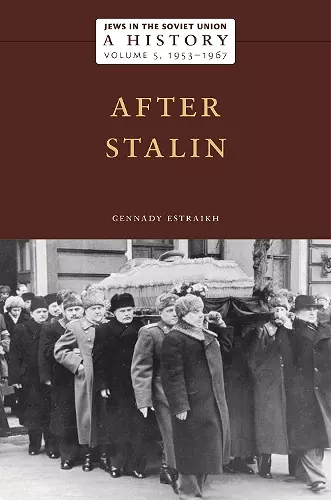Jews in the Soviet Union: A History
After Stalin, 1953–1967, Volume 5
Format:Hardback
Publisher:New York University Press
Published:20th Dec '22
Should be back in stock very soon

Offers an analysis of Soviet Jewish society after the death of Joseph Stalin
At the beginning of the twentieth century, more Jews lived in the Russian Empire than anywhere else in the world. After the Holocaust, the USSR remained one of the world’s three key centers of Jewish population, along with the United States and Israel. While a great deal is known about the history and experiences of the Jewish people in the US and in Israel in the twentieth century, much less is known about the experiences of Soviet Jews. Understanding the history of Jewish communities under Soviet rule is essential to comprehending the dynamics of Jewish history in the modern world. Only a small number of scholars and the last generation of Soviet Jews who lived during this period hold a deep knowledge of this history. Jews in the Soviet Union, a new multi-volume history, is an unprecedented undertaking. Publishing over the next few years, this groundbreaking work draws on rare access to documents from the Soviet archives, allowing for the presentation of a sweeping history of Jewish life in the Soviet Union from 1917 through the early 1990s.
Volume 5 offers a history of Soviet Jewry from the demise of the brutal dictator Joseph Stalin to the military confrontation between Israel and Arab states in 1967 known as the Six-Day War. Both historic events deeply affected Soviet Jews, who numbered over two million in the wake of the Holocaust and still formed at that point the second-largest Jewish population in the world. Stalin’s death led to the release of political prisoners and the reduction of the level of fear in society. The economy was growing and conditions of life were improving. At the same time, the state had doubts about the loyalty of the Jewish population and imposed limitations on their educational and career prospects. The relatively liberal period associated with Nikita Khrushchev’s “thaw” after the Stalinist bitter frost became a prelude to the years when contemplation about, or practical steps toward, emigration to Israel or elsewhere began to play an increasing role in the lives of Soviet Jews.
In this pioneering analysis of the “thaw” years in Soviet Jewish history, Gennady Estraikh focuses both on the factors...
Jewish emigration from the Soviet Union was a heated and complex issue in the Western press and international politics from the 1960s. Gennady Estraikh offers an informed insider’s perspective that adds a valuable new dimension. -- Sheila Fitzpatrick, Institute of Humanities and Social Sciences, Australian Catholic University
A deeply researched, historical account of Soviet Jewry in the years between the death of Joseph Stalin in March 1953 and the Six-Day War in June 1967. First under Nikita Khrushchev and then under Leonid Brezhnev, Soviet Jews began to assert their identity as Jews and found themselves ready to campaign for their right to leave for Israel and the West. . . . An indispensable resource for anyone with an interest in the history and tragic fate of a Jewish community that had been torn asunder by the Holocaust and decades of forced assimilation and murderous repression by the Kremlin, and then learned how to challenge Bolshevik rule and be Jews again. -- Joshua Rubenstein, Harvard University
ISBN: 9781479819461
Dimensions: unknown
Weight: 785g
432 pages